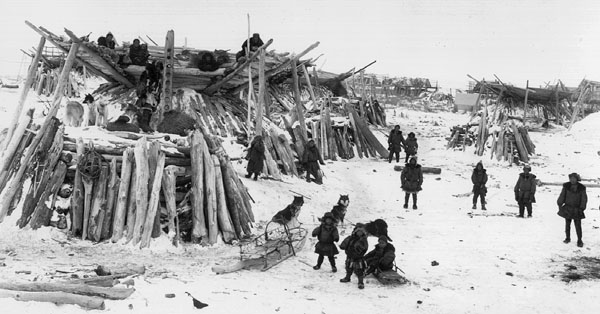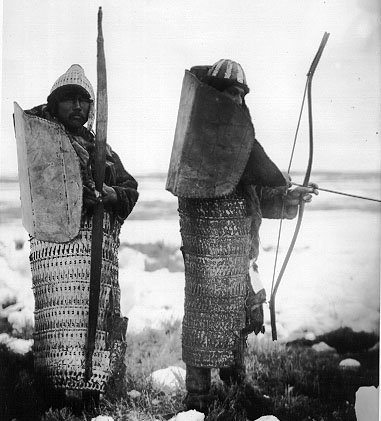
Koryaks are an indigenous north-east Asian people living on the northern part of the Kamchatka peninsula and surrounding mainland in what is now the Russian Federation. They were conquered by Cossack pioneer-adventurers in the end of the seventeenth century and more or less incorporated into the Russian empire by the middle of the eighteenth. The Tsar levied an annual fur tribute on all adult males and demanded some transportation services, but otherwise left them alone. The Soviets collectivized their subsistence production, and Stalin's Terror saw many shamans and successful reindeer herders summarily executed.
The Koryak Autonomous Region (KAR)1 is located in the far northeast of the Russian Federation, occupying the northern half of the Kamchatka Peninsula and adjacent mainland. Just a little larger than Arizona, and with a current population of fewer than 35,000 people, the Region was established in 1930 along with several others as a territorial manifestation of the Communist Party's dedication to individual nationalities' "rights" to their distinct cultures.
Soviet government policy was based upon a theory of culture that reified the dynamic, fluid interactoins of people identifying themselves in complex ways that defy the simple categorization of censes.
Quick sketch of Soviet cultural theory underpinning government policy
After World War II the autonomous regions created for groups like the Koryak were subordinated to neighboring provinces, and thus the Koryak Autonomous Okrug (Region) became part of the Kamchatka Province, and its counties were little differentiated from the other counties in Kamchatka Province. When the Soviet Union fell apart in 1991, the ten autonomous regions in Russia asserted true autonomy from Moscow and declared themselves separate from the provinces to which they had been subordinated. Shortly thereafter Yeltsin declared the congerie of administrative territories within the Russian Federation (republics, provinces, regions, territories) to be "equal subjects of the Federation." Now the Koryak Autonomous Region is presented with the task of creating an economic and administrative infrastructure. The regional administration must deal with four different constituencies as it constructs a self-standing administrative/territorial unit: the center in Moscow, Kamchatka Provincial officials, potential foreign business investors, and the local people of the KAO.
Vladimir Jochelson conducted ethnographic research during an expedition in 1900-01 as part of the Jesup North Pacific Expedition managed by Franz Boas and the American Museum of Natural History. These black and white pictures of Koryak people living in the northern areas around Penzhinsky Bay were taken by Jochelson and his wife Dina Brodskaya. Images on this page are from the American Museum of Natural History. Brodskaya also served as expedition physician and carried out the physical anthropological research, which later formed some the data for her dissertation.

 Photograph is from the American Museum of Natural History,
negative #4140. These Koryak people are standing on the roof of their winter
house. The smoke hole in the center also served as an entrance via a ladder
similar to the one in the picture. The roof was built with eaves to keep snow
from drifting over the top of the house. It also afforded shelter for dogs,
as we can see in the foreground. The dog impaled on a post to the left is an
offering to local spirits.
Photograph is from the American Museum of Natural History,
negative #4140. These Koryak people are standing on the roof of their winter
house. The smoke hole in the center also served as an entrance via a ladder
similar to the one in the picture. The roof was built with eaves to keep snow
from drifting over the top of the house. It also afforded shelter for dogs,
as we can see in the foreground. The dog impaled on a post to the left is an
offering to local spirits.
Spiritual forces in traditional Koryak religion are associated with a particular geography, like a region, a hill, or even a house. Spirits from one place had to be kept separate from spirits associated with other places, therefore visitors would be "cleansed" by a brief ritual involving smoke and a few words. A spiritually "charged" drum used for shamanic healing was not carried from house to house by an individual shaman, but rather each household had a drum associated with the spirits of that place, which a shaman would use to talk to the spirits and heal a sick person. Scholars often refer to this kind of shamanic activity as "familial shamanism." Each family had a person who was skilled in drumming and had some influence with spirits, and he or she would heal family and friends. Professional shamans, like those known among the Evenk (Tungus) or Sakha (Yakut) were unknown among Koryaks.
 Photograph is from American Museum of Natural History, negative
#1543. These two men are modeling armor Jochelson purchased for the American
Museum of Natural History. By the nineteenth century Koryaks were all using
firearms, but bows and armor were kept as family heirlooms. A very few people
keep them to this day. Warfare was a small-time affair of raids and revenge
among the Koryaks and other Siberian native peoples in the area, but Koryak
did suffer heavily under constant raiding by Chukchi to the north during the
seventeenth and eighteenth centuries.
Photograph is from American Museum of Natural History, negative
#1543. These two men are modeling armor Jochelson purchased for the American
Museum of Natural History. By the nineteenth century Koryaks were all using
firearms, but bows and armor were kept as family heirlooms. A very few people
keep them to this day. Warfare was a small-time affair of raids and revenge
among the Koryaks and other Siberian native peoples in the area, but Koryak
did suffer heavily under constant raiding by Chukchi to the north during the
seventeenth and eighteenth centuries.
Jochelson acquired all kinds of things during his expedition sponsored by the museum. The collections include all manner of tools, clothing, toys, weapons, models of houses, sleds, and traps, and even underwear and diapers. Diapers were made of reindeer hide (like most Koryak clothing) and lined with reindeer moss, which is considered to be very hygenic. Women also used reindeer moss during their menses, and this prevented infections of various sorts.
1I translate okrug as "region," oblast as "province," and rayon as "county" in order to convey the administrative hierarchy inherent in their official usage. Return to text
Page Date: March 27, 2002